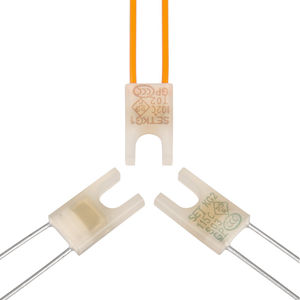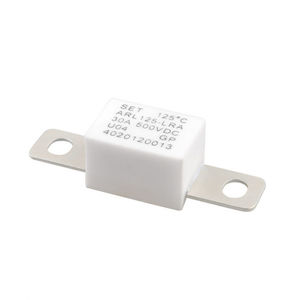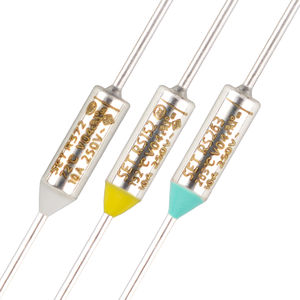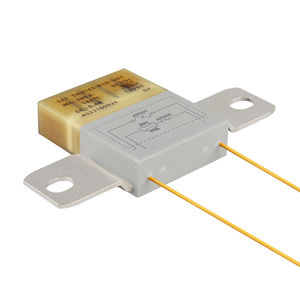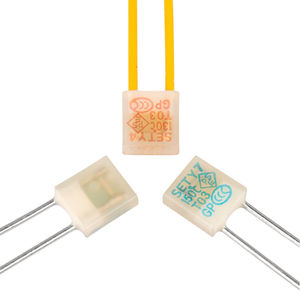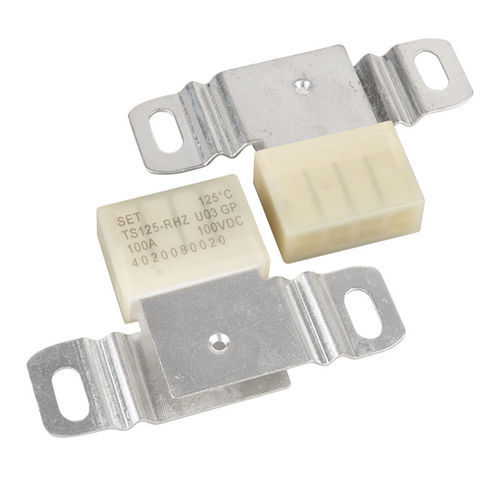
- Electricity - Electronics
- Switch and Relay
- Radial fuse
- Xiamen SET electronics Co.,Ltd
Radial fuse-link TS seriesthermalelectronic equipmentbattery

Add to favorites
Compare this product
Characteristics
- Configuration
- radial
- Type
- thermal
- Applications
- electronic equipment, battery
- Amperage
80 A, 100 A
- VAC
250 V
- VDC
100 V, 125 V
- Service temperature
Max.: 136 °C
(277 °F)Min.: 102 °C
(216 °F)- Width
45.5 mm
(1.8 in)- Length
73 mm
(2.9 in)- Height
11.8 mm
(0.5 in)
Description
DC-Alloy Thermal-Link / DC-Alloy Thermal Cutoff (DC-ATCO) is defined as a non-resettable protective device functioning one time only. It is widely used in electrical equipment and electric vehicle. DC-ATCO is mainly consist of Thermal Element, Flux Resin, Case, Sealant and Lead Wires. Normally, thermal element is jointed to the two lead wires. Under abnormal conditions, when the temp. reaches to the fusing temp. of DC-ATCO, the thermal element melts and quickly retracts to the two lead wire ends with the aid of the flux resin and disconnects the circuit completely.
SETsafe | SETfuse DC-Alloy Thermal-Link is classified into Axial and Radial shapes, with Rated Current 10 A to 200 A, Rated Functioning Temp. 76 °C to 230 °C, with UL, cUL , Approvals and RoHS, REACH compliant.
● Non-Resettable
● High Accuracy of Functioning Temp.
● RoHS & REACH Compliant
Mounting Style
Stud, Soldering
For product quality, our goal is to be industry-leading. We ensure that the quality of the product meets the expected goals from the following process.
Quality Policy.
Qualified Supplier of Raw Materials.
Incoming Quality Control (IQC):
Acceptance Quality Limit (AQL), Dimension, Function, Visual Inspection, RoHS & REACH Test. etc..
Catalogs
No catalogs are available for this product.
See all of Xiamen SET electronics Co.,Ltd‘s catalogsOther Xiamen SET electronics Co.,Ltd products
Over Temperature Protection
Related Searches
- Surge protector
- DIN rail surge protector
- Low-voltage surge protector
- Power supply surge protector
- AC surge protector
- Multipole surge protector
- Remote signaling surge protector
- Three-phase surge protector
- Cylindrical fuse-link
- Class II surge arrester
- Power fuse
- 2-pole surge protector
- DC surge protector
- Single-pole surge protector
- Fast-acting fuse-link
- Varistor surge protector
- SETsafe SETfuse ceramic fuse
- 4-pole surge protector
- Photovoltaïc installation surge arrester
- Class I surge protector
*Prices are pre-tax. They exclude delivery charges and customs duties and do not include additional charges for installation or activation options. Prices are indicative only and may vary by country, with changes to the cost of raw materials and exchange rates.



